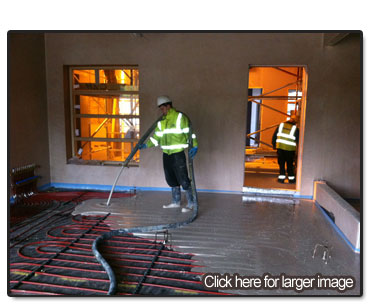
Flowing Screed
Gyvlon liquid flowing screed are based on unique synthetic anhydrite binder rather than Cement giving them many benefits over cement screeds, the most obvious difference is their fluid application compared to semi dry cement screeds, but Gyvlon also offers, higher compressive and flexural strength, lower shrinkage, eliminates reinforcement, improved surface finish and greatly improved underfloor heating performance.
Gyvlon flowing screed achieve this by offering higher thermal conductivity and reduceding cover to the heating pipes, greatly improving the heat performance and reaction times of the screed, this allows for a more reactive system requiring a smaller amount of energy input. The system temperature is easier to regulate due to its responsive nature allowing the building to achieve a constant temperature without the variability and thermal over shoot associated with thicker section sand cements and concretes.
Flowing Screed Site Preparation
Prior to the flowing screed being applied, the building should be weathertight, with the roof installed, and any opening being covered with polythene of ply sheeting.
Flowing Screed General Preparation
Where flowing screed is to be applied over insulation the boards should be installed flat to substrate and be free from excessive movement/rocking. The perimeter strip should be installed to all walls within the screed. The strip should be installed and should be pushed fully into all corners.
The insulation should then be overlaid using minimum 500 gauge polythene overlapped by 100mm and taped, cut flush to the perimeter strip. The polythene should be laid flat with minimal ridges (we recommend single wound roll).
The perimeter strip’s skirt can then be sealed to polythene using tape*.
Under floor heating pipes should be installed to manufacturer’s spacing’s and guidelines, as a minimum the pipe should be secured using either a clip rail or staple every 400mm. The pipe should be well secured to prevent floating during the application of the flowing screed.
The pipe work must be pressure tested (preferably with water) prior to installation of screed, this is to ensure there are no leaks.
Finished preparation should be completely water tight to prevent leaking.
After Screeding: The building/area should be left as sealed as possible to prevent through draft or rain entering the building. Once the screed is 48 hours old the building can be opened to allow air movement and encourage the drying of the screed.
In the interest of optimum drying performance efforts should be made to prevent moisture ingress to the screed.
Advantages of liquid flowing screed are
• Up to 2000m2 per day productivity
• Foot traffic within 24 to 48 hours
• Joints at 30-40 linear meters
• Very low shirnkage
• Minimal cracking
• Will not curl
• No reinforcement required
• Eco friendly calcium sulphate binder
Home |
Under Floor Heating |
Wet Screed |
Dry Screed |
Wet Screeding |
Flowing Screed |
Dry & Wet Screed |
Contact Us
|
